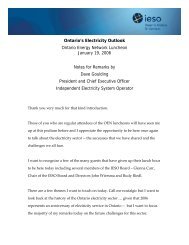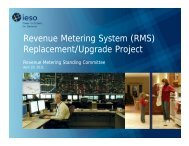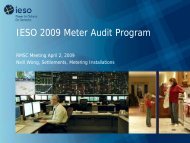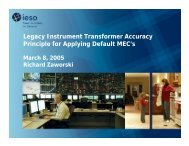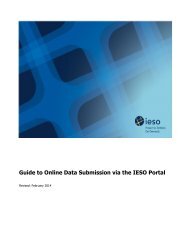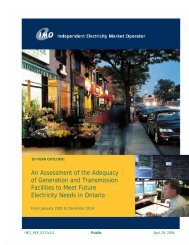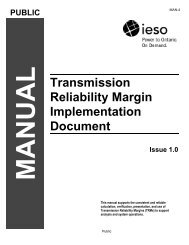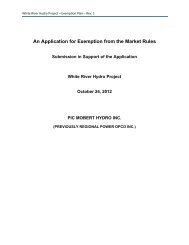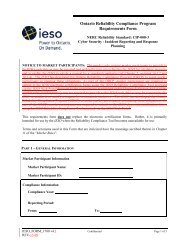Participant Technical Reference Manual - IESO
Participant Technical Reference Manual - IESO
Participant Technical Reference Manual - IESO
Create successful ePaper yourself
Turn your PDF publications into a flip-book with our unique Google optimized e-Paper software.
<strong>Participant</strong> <strong>Technical</strong> <strong>Reference</strong> <strong>Manual</strong><br />
4. Operational Metering Equipment & AGC<br />
4. Operational Metering Equipment &<br />
AGC<br />
239 (For supporting rule references, please refer to “Appendix 2.2, Section 1.2 of<br />
the market rules”)<br />
4.1 Operational Metering Equipment<br />
4.1.1 Introduction<br />
240 This section covers operational metering requirements. It does not cover<br />
specific revenue metering requirements.<br />
241 Real-time operational information from market participants is required by the<br />
<strong>IESO</strong> for the operation of the high voltage electricity system. Market<br />
participants provide this information by using appropriate monitoring<br />
equipment that they supply. The information is sent to the <strong>IESO</strong> over <strong>IESO</strong><br />
provided Real Time Network.<br />
242 Specifics for the types of monitoring equipment required by the <strong>IESO</strong> are<br />
detailed in the “Market Rules”, Chapter 4. The requirements in terms of<br />
quantities measured and performance for operational metering are mainly based<br />
on the facility ratings.<br />
243 Remote real-time data can be provided to the <strong>IESO</strong> by the market participants<br />
using two standard data transfer protocols:<br />
a. Distributed Network Protocol (DNP), and/or<br />
b. Inter Control Center Protocol (ICCP).<br />
4.1.2 Qualified Devices<br />
244 The standard device for collecting real-time information is the Remote<br />
Terminal Unit (RTU). Real-time information about the disposition of the<br />
market participants’ facility is collected from the market participant supplied<br />
RTU‟s and forwarded on a regular basis to the <strong>IESO</strong> Control Center. The<br />
Energy Management System (EMS) at the <strong>IESO</strong> Control Center polls the RTUs<br />
for information every two to four seconds. Total data latency must not exceed<br />
four seconds.<br />
245 The EMS communicates with the RTUs using the DNP 3.0 protocol. The<br />
Binary Input Data are Object 1, Qualifier 01, Variation 1 (normal) and<br />
Variation 2 (not normal). The Analog Input Data are Object 30, Qualifier 01,<br />
Variation 4 (normal) and Variation 2 (not normal) with Application Confirm<br />
Request. All data must show Data Quality Flags when not normal, such as Off<br />
Line, Restart, Communication Lost, Local/Remote Forced, Over-range. If data<br />
are derived from some intermediate devices, these flags must indicate any<br />
manual manipulation or failure of these data in these devices. Pseudo data do<br />
not require any Data Quality Flags.<br />
Issue 21.1 – March 15, 2010 - estimated Public 69




